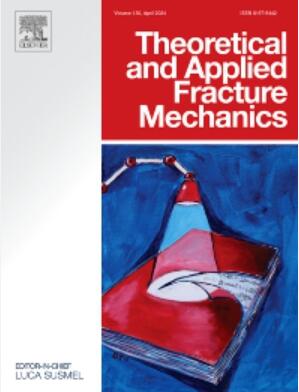A phase-field model for stress-assisted hydrogen diffusion and fracture: An Abaqus implementation
IF 5.6
2区 工程技术
Q1 ENGINEERING, MECHANICAL
引用次数: 0
Abstract
Hydrogen dissolved in metals – whether from either internal or external sources – can significantly degrade mechanical properties by interacting with material defects. In the present work, a comprehensive finite element framework for modelling the coupled deformation-diffusion-fracture problem is discussed. A staggered approach is employed to solve the coupled problem, where displacement, crack phase-field, and concentration fields are weakly coupled. A novel implementation of phase-field modelling for hydrogen-assisted fracture is developed within Abaqus/Standard, employing user-defined UEL and UVARM subroutines. The detailed implementation procedure facilitates modelling hydrogen-assisted fracture and similar coupled problems, providing researchers with a practical and accessible computational approach. The finite element code developed for one of the numerical simulations is available at: https://github.com/shivareddykondakindi/HED-Abaqus.git.
应力辅助氢扩散和断裂的相场模型:Abaqus实现
溶解在金属中的氢——无论是来自内部还是外部——都会通过与材料缺陷相互作用而显著降低机械性能。在本工作中,讨论了一个综合的有限元框架来模拟变形-扩散-断裂耦合问题。采用交错法求解耦合问题,其中位移场、裂纹相场和浓度场是弱耦合的。在Abaqus/Standard中,采用用户定义的UEL和UVARM子程序,开发了氢辅助压裂相场建模的新实现。详细的实现程序便于对氢辅助破裂和类似耦合问题进行建模,为研究人员提供了一种实用且易于获取的计算方法。为其中一个数值模拟开发的有限元代码可在:https://github.com/shivareddykondakindi/HED-Abaqus.git上获得。
本文章由计算机程序翻译,如有差异,请以英文原文为准。
求助全文
约1分钟内获得全文
求助全文
来源期刊

Theoretical and Applied Fracture Mechanics
工程技术-工程:机械
CiteScore
8.40
自引率
18.90%
发文量
435
审稿时长
37 days
期刊介绍:
Theoretical and Applied Fracture Mechanics'' aims & scopes have been re-designed to cover both the theoretical, applied, and numerical aspects associated with those cracking related phenomena taking place, at a micro-, meso-, and macroscopic level, in materials/components/structures of any kind.
The journal aims to cover the cracking/mechanical behaviour of materials/components/structures in those situations involving both time-independent and time-dependent system of external forces/moments (such as, for instance, quasi-static, impulsive, impact, blasting, creep, contact, and fatigue loading). Since, under the above circumstances, the mechanical behaviour of cracked materials/components/structures is also affected by the environmental conditions, the journal would consider also those theoretical/experimental research works investigating the effect of external variables such as, for instance, the effect of corrosive environments as well as of high/low-temperature.
 求助内容:
求助内容: 应助结果提醒方式:
应助结果提醒方式:


